Pacific X Force Pro No. 1 Racquet Review
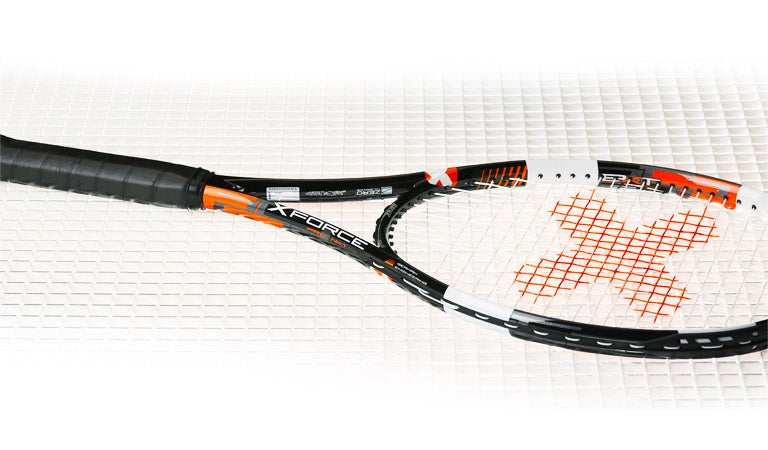
Summary
Players who appreciate precision and feel in a racquet will want to take a serious look at Pacific's X Force Pro No. 1. Pacific harmoniously blends speed and control in this evolution of the control-oriented Pro No. 1 racquet. Players will also enjoy the crisp, comfortable response from this 98 square inch frame and its Basalt X Technology. Our playtesters loved the precise control they had with this lower powered racquet, but they also found a small sweetspot and a lack of access to spin from the baseline. They did enjoy the maneuverability of this racquet on volleys and service returns. Overall, we think this is a great offering from Pacific, especially as a great starting point for customization. Some added weight to the hoop will open up the sweetspot and build on an already solid racquet.
Pacific X Force Pro No. 1 Racquet Scores
| Power | 64 |
| Comfort | 83 |
| Touch/Feel | 76 |
| Serves | 82 |
| Groundstrokes | 76 |
| Returns | 73 |
| Slice | 75 |
| Topspin | 79 |
| Volleys | 77 |
| Overall | 76 |
Groundstrokes - Score: 76
The control-oriented feel and playability of the X Force Pro No. 1 gelled well for all four of our playtesters and their different playing styles once they got familiar with its control-oriented feel and playability. Finding a plush, low-powered response from the baseline, Andy could swing big without fear of the ball sailing long. He began, "After a brief adjustment period I appreciated the awesome control this racquet offered, and I got pretty dialed in off both sides. Off-center contact never felt jarring, however, it took some time to for me to get used to the racquet, especially on my backhand side where my flatter shots were leaving at a lower trajectory than usual. I had to adjust my swing to more of a low-to-high path to get the ball over the net. Lastly, I did find the sweetspot to be pretty small, making it a little less forgiving than other racquets with the same head size."
Once Marco got his timing figured out, the racquet was great to play with from the baseline. He explained, "At the start of the playtest the X Force Pro No. 1 felt like it had a 93 square inch head, as opposed to a 98 square inch head, just because the sweetspot is fairly small. The ball came off the stringbed at a fairly low trajectory even when I was trying to really lift it up over the net, which was unusual. Once I got in a groove on my strokes I accessed the great control and power potential this racquet offered."
"The control was my favorite aspect of this racquet when I was hitting groundstrokes," began Troy. "I enjoyed being able to swing freely with this racquet in hand, and I felt like I could hit my targets. I was getting good directional control on my forehands and backhands, but I had to adjust to the low trajectory and aim higher over the net to get ample clearance. I felt this racquet lacked some plow through because the weight and swingweight are lower than what I'm used to. The lack of plow through was most evident on my backhand slice, where the racquet felt a bit unstable and I wasn't getting the easy depth that I find with some of the heavier racquets. Another downside for me was the sweetspot, which felt smaller than the sweetspot on most 98 square inch racquets I have tested, resulting in a dead feel when the ball hit outside the sweetspot."
Michelle was pleasantly surprised with her hitting experience with this racquet, and offered, "From the first hit I enjoyed the controlled response, and I could hit out with confidence. My PlaySight data showed that the X Force Pro No. 1 has less raw power than my Wilson Pro Staff RF97 Autograph, and I also noticed a small sweetspot. It was awesome when I found the sweetspot, but when I hit just outside of it my balls were landing short or I didn't have enough oomph behind the ball. It was tough to hit with a lot of spin with this racquet; even when I exaggerated getting under the ball I still struggled with some net clearance issues. However, I liked how I could go after the ball and be aggressive without overhitting. My main struggle came when I was playing against someone who could dish my ball right back. On our slower TW court it took several attempts to put the ball away, which sometimes resulted in me missing the sweetspot and not attacking consistently."
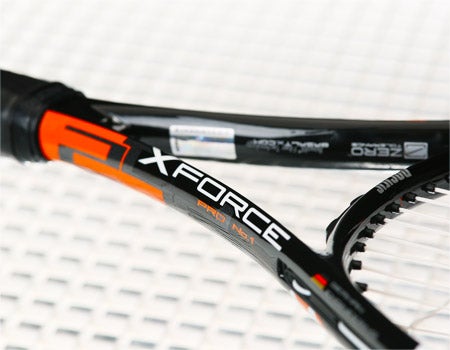
Volleys - Score: 77
Maneuverability was the name of the game with the X Force Pro No. 1 at net. Marco had no issues when volleying, saying, "It was easy to get the racquet set for low, high and wide balls. I would put a little more mass in the head with some tungsten tape to help stick volleys through the court more effortlessly."
Troy also noted how the maneuverability of this racquet made it easy to attack when rushing the net. "The fast feel was most noticeable during doubles play, where I could manipulate the X Force Pro No. 1 with ease during quick exchanges at the net. The control level allowed me to find the corners of the court and carve up some sharp angles. The downside was that this racquet felt a bit unstable when facing big hitters. It got pushed around anytime I didn't make contact in the sweetspot."
"This racquet was maneuverable and very precise," said Michelle. "It was easy to volley well with this racquet. I enjoyed the feel up at the net. Balls that were hit hard at me were a little trickier to consistently place deep because of that smaller sweetspot, but I could carve out some nice angles and touch drop volleys."
The excellent precision and soft feel at net pleased Andy. He said, "Any time I used a compact, simple stroke I was able to find the sweetspot and put the ball where I wanted consistently. However, whenever I took a bigger stab at a volley the racquet didn't feel forgiving and I'd miss the small sweetspot, causing me to drop too many volleys short in the court. The racquet really made me use good technique around the net, but I would've liked it to be a bit more forgiving."
Serves - Score: 82
Our playtesters sacrificed some power for precision when serving with the X Force Pro No. 1. For Troy, the maneuverability of this racquet helped him add variety and spin to his serves. He said, "The whippy feel made it easy to pronate my wrist and allowed me to get good pop on flat, first serves. I found my kick serve to be consistent, although I wasn't quite getting the spin that I find with racquets that have a more open string pattern. Finding my targets within the service box was easy to do with this racquet, and it allowed me to keep my opponents off rhythm. My one knock on serving with this racquet was that I wasn't quite getting the power that I get from racquets with more mass."
Similar to her groundstroke experience, Michelle found the X Force Pro No. 1 working for her game fairly quickly. She noted, "I was hitting targets and getting some decent pace. I really could key in and hit exactly where I was aiming. I was effective slicing balls into the body or out wide on first serves. I felt confident hitting my spots throughout the playtest, and I didn't have any problems remaining consistent on my serves. I didn't mind sacrificing some speed for precision, and my serves were just as effective, maybe even more so."
Andy also served well with this racquet. He added, "I loved the precision the X Force Pro No. 1 offered when I was going for my spots, and I found more than enough access to power and spin. You're not going to be blasting your opponents with big flat first serves, but you can be effective moving your serves around the box and mixing up your pace and spin. I felt very comfortable during my service games with this racquet."
Marco wasn't serving as big or with as much movement as he normally does with this racquet, but he thought some customization would make it work more effectively for him. He explained, "I could really go after my serve and still access enough control, which made me feel like I could place the ball well. I didn't get quite the amount of spin on kick serves that I'm used to, and again, some tungsten tape in the upper hoop could open up the sweetspot and get some more action on the ball."
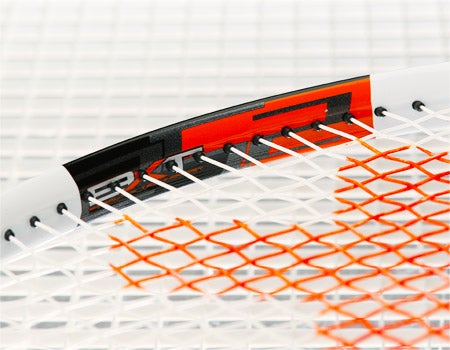
Returns - Score: 73
Returning with the X Force Pro No. 1 proved to be a bit more demanding. Michelle's biggest issue with this racquet was the weight and swingweight being lower than her RF97, which caused her to slap at some returns. She said, "I found myself slapping the ball, especially when I had time to take a big swing. I also thought it was harder to generate power when I was attacking my returns, which encouraged the slap return. It was fairly easy to block back bigger first serves, but I did struggle to hit consistently deep returns, and I was looking for more plow through when blocking back returns with slice."
"Returning serve was great with this racquet," said Andy. "It offered a nice, precise response that allowed me to take short swings and place the ball where I wanted. Any time It was a little more difficult to find the sweetspot any time I took a bigger swing, but this racquet encouraged (almost required) good technique. The X Force Pro No. 1 lacked a little bit of heft when I was punching back chip returns, but this racquet will work out well for you if you like to hit the ball early with a compact swing."
The maneuverability of this racquet really helped Marco on his returns, and it enabled him to use a quick take back and swing. He said, "This racquet wasn't as comfortable on off-center returns, which were slightly challenging to place where I wanted. Not to sound like a broken record, but tungsten tape at 10 and 2 would help by opening up the sweetspot."
The lack of stability and a relatively small sweetspot made it hard for Troy to attack with his returns. He added, "The lack of plow through was evident when I didn't have time to take a full swing at my return -- the backhand slice return, for example. Many times I found my returns landing short in the court, and this allowed my opponent to take control of the point. Hitting a clean return was not that common due to the small sweetspot."
Overall - Score: 76
| Technical Specifications | ||
|---|---|---|
| Length | 27 in | 69 cm |
| Head Size | 98 sq in | 632 sq cm |
| Weight | 11.5 oz | 326 gm |
| Balance Point | 12.75 in 32 cm | 6pts Head Light |
| Construction | 24 - 26 - 23 Tapered Beam | |
| Composition | Basalt/Graphite | |
| String Pattern | 16 Mains / 20 Crosses | |
| Babolat RDC Ratings | ||
|---|---|---|
| Score | Grade | |
| Flex Rating | 63 | Range: 0-100 |
| Swing Weight | 316 | Range: 200-400 |
| Andy's Scores | |||
|---|---|---|---|
| Power | 5 | Serves | 8 |
| Control | 9 | Groundstrokes | 8 |
| Maneuverability | 7.5 | Returns | 8 |
| Stability | 7 | Slice | 6.5 |
| Comfort | 8.5 | Topspin | 8.5 |
| Touch/Feel | 7 | Volleys | 7 |
| Overall | 7.2 | ||
| Marco's Scores | |||
|---|---|---|---|
| Power | 8 | Serves | 8.5 |
| Control | 8.5 | Groundstrokes | 7.5 |
| Maneuverability | 9 | Returns | 7.5 |
| Stability | 7.5 | Slice | 8 |
| Comfort | 8.5 | Topspin | 8 |
| Touch/Feel | 8 | Volleys | 8 |
| Overall | 8 | ||
| Troy's Scores | |||
|---|---|---|---|
| Power | 5.5 | Serves | 8.3 |
| Control | 8.5 | Groundstrokes | 7 |
| Maneuverability | 8.5 | Returns | 5.9 |
| Stability | 6.8 | Slice | 8 |
| Comfort | 8.5 | Topspin | 7.5 |
| Touch/Feel | 7.8 | Volleys | 7.7 |
| Overall | 7.5 | ||
| Michelle's Scores | |||
|---|---|---|---|
| Power | 7 | Serves | 8 |
| Control | 8 | Groundstrokes | 8 |
| Maneuverability | 7.5 | Returns | 7.7 |
| Stability | 7.8 | Slice | 7.5 |
| Comfort | 7.7 | Topspin | 7.5 |
| Touch/Feel | 7.6 | Volleys | 7.9 |
| Overall | 7.7 | ||
Playtester Profiles
Andy: Open level all court player with a semi-western forehand grip and a two-handed backhand. Andy currently using a Yonex EZONE Ai 98.
Marco: Open level lefty aggressive baseliner with a semi-western forehand and a one-handed backhand. He currently plays with a Wilson Blade 98 16x19.
Michelle: Open level baseline player with a semi-western forehand and a two-handed backhand. She currently plays with the Wilson Pro Staff RF 97 Autograph.
Troy: 5.0 lefty all-court player with a full Western Forehand and a two-handed backhand. Troy currently plays with a Wilson BLX Six.One 95.

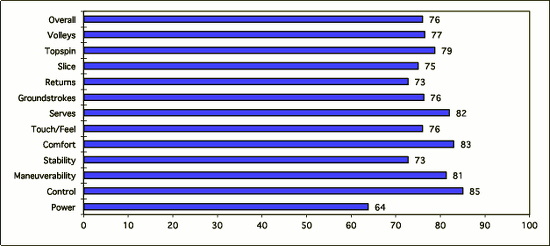



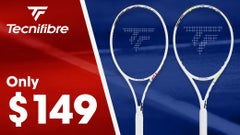


Likes
Andy - "The soft, plush feel and great control from every area of the court."
Marco - "The good control and maneuverability worked well for big, fast swings."
Troy - "I found good control and easy maneuverability."
Michelle - "The X Force Pro No. 1 had precise feel and made it easy for me to hit my targets when I was serving."
Dislikes
Andy - "The X Force Pro No. 1 has a small sweetspot that was difficult to find consistently. It lacked easy power when I wasn't in perfect position."
Marco - "The smaller sweetspot."
Troy - "I found this racquet to have a smaller sweetspot than most 98 square inch racquets; it played more like a midsize for me. It lacked plow through and power compared to my racquet of choice."
Michelle - "The smaller sweetspot affected my depth and put-away power, which hindered my game style."
Comparing the racquet to others they've tried, our testers said:
Andy - "The X Force Pro No. 1 kept reminding me of the Prince Tour Pro 100 because of its plush feel and exceptional control. In my opinion, both racquets are meant for baseliners who like to slug the ball and move their opponents around during long rallies. I did find the larger sweetspot of the Tour Pro 100 to be a little more forgiving, but this option from Pacific is certainly great for baseliners looking for a more traditional feel."
Marco - "This frame played similar to the Tecnifibre TFight 305 Dynacore. Both had slightly smaller sweetspots and swung really fast through the air, which was a positive."
Troy - "This Pacific version feels similar to the original Fischer M Pro No. 1, but with a crisper response. Another similar racquet is the Head Graphene Speed Pro, but this Pacific X Force Pro No. 1 has less stability and power."
Michelle - "This racquet reminded me a bit of the Babolat Pure Strike 16x19. Although I would say the X Force No. 1 felt lower powered and a little less spin friendly than the Strike."